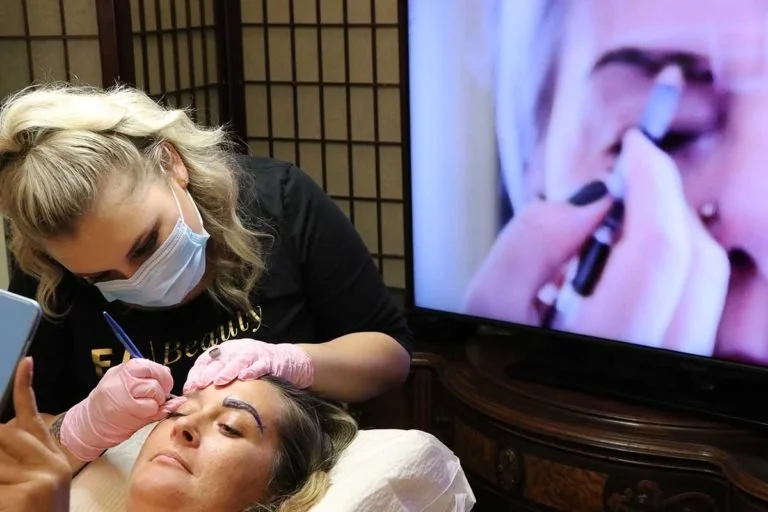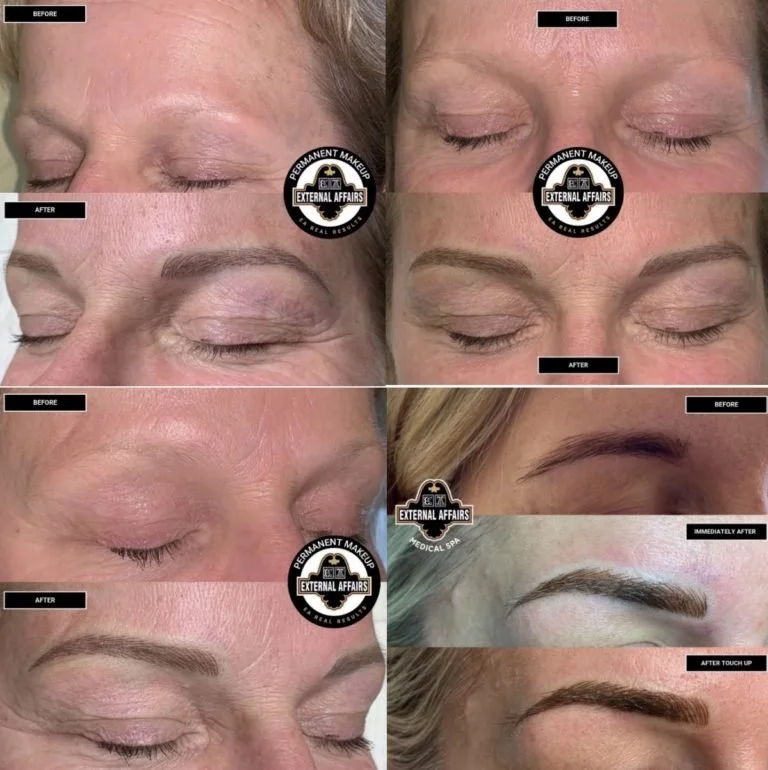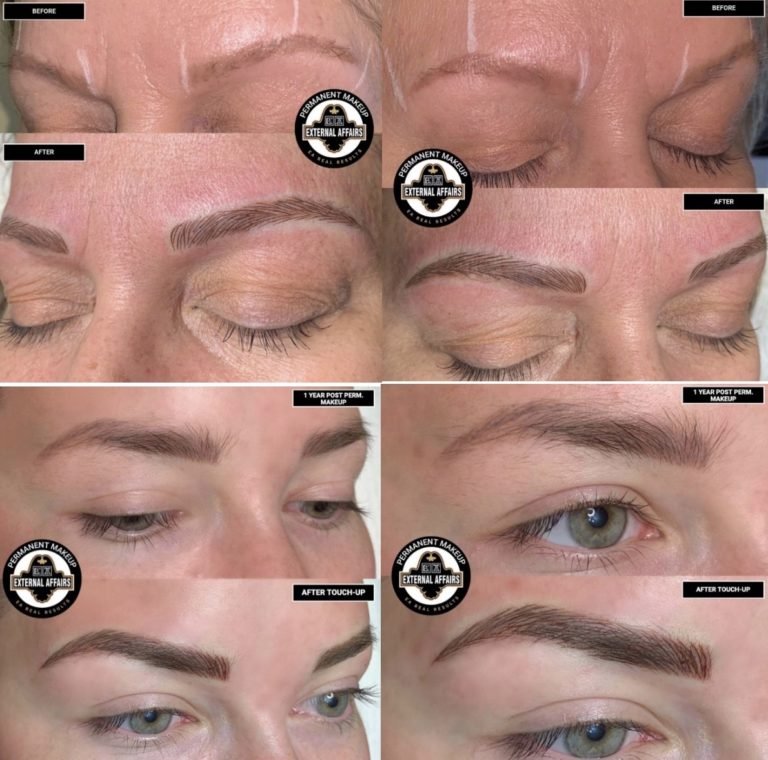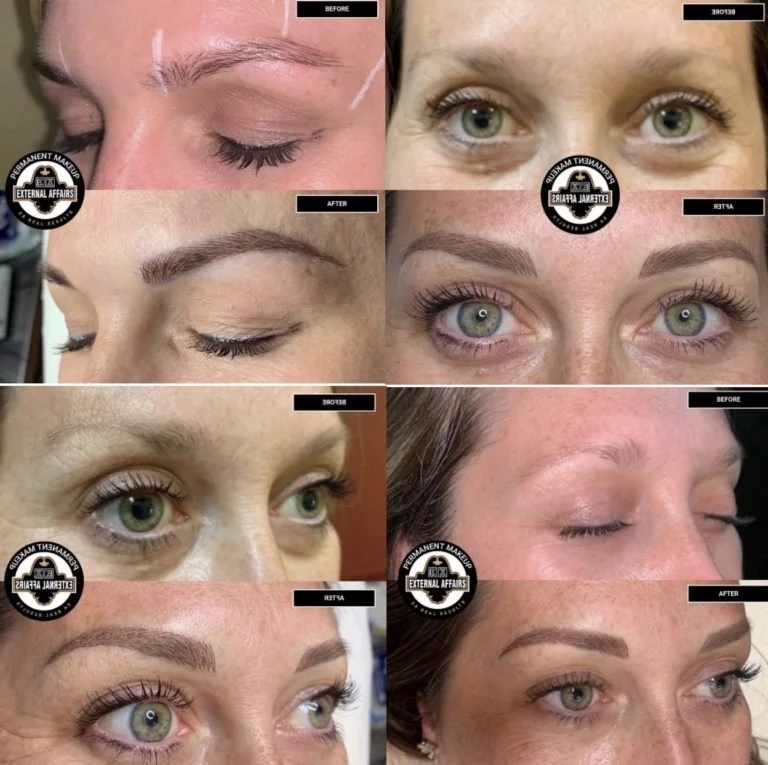All You Need To Know About Microblading
Microblading is a semi-permanent tattoo technique used to fabricate the appearance of fuller brows using a hand held tool made of several tiny little needles to manually draw hair strokes into the skin.
What’s the benefit?
Opens the eye area making a person look more awake and creates the look of an eyelift
Takes less time to get ready in the morning
Takes 5-10 years off of someone’s age
Creates the illusion of a fuller, more youthful brow by creating a nicer shape
Helps with self confidence
What is the Difference Between Microblading and Permanent Makeup?
Microblading resembles individual hairs by making very superficial hair stokes in the skin. Using this technique will last anywhere from 10-14 months.
The hair strokes are quite a bit thinner and a little more natural looking than permanent makeup. Microblading takes about a week to heal and typically has minimal scabbing and peeling.
Permanent makeup uses a heavier tattoo type tool that penetrates deeper into the dermis leaving you with results for 2-3 years.
The strokes are a bit thicker and usually darker. Permanent brows take about 2 weeks to heal and will have more scabbing and peeling.
Contrary to its name, permanent makeup is not permanent and will fade over time. It’s up to the client which they would prefer, but we usually don’t recommend permanent makeup for extremely fair/light haired people as it may look too dramatic.
Can I Switch Between the Two?
Yes! Microblading and permanent brows are the same cost. Touch up procedures (1 year for microblading and 2-3 years for permanent) are half price. If you choose to switch between the two there will be no extra cost, just the cost of a touch up.
We recommend microblading to start with to ease the client into the process. But we always let the client know they do have the option to switch to permeant at their yearly touch up for the same touch up fee.
How Do You Measure the Brows?
At External Affairs every client must be measured according to the ratio of PHI. The golden ratio is found extensively within all things in art and nature that are considered beautiful.
"To the Greek mentality, the golden ratio was an attribute of beauty. Both ancients and moderns believed that there is a close association in mathematics between beauty and truth."
The Greeks believed there to be three aspects to beauty: symmetry, proportion and harmony.
This golden ratio is 1:1.618. With this ratio everyone’s brows are completely proportionate to each individual. We use the measurement (1) the distance between the eyes which gives us how far apart the brows are going to be, that same measurement (1) is used to determine where the arch will go. The next measurement (1.618) will determine how long the brow is.
We always try to raise the tail of the brow to be equal to or slightly above the head of the brow. When the tail falls below the head it creates the illusion of a “sad brow”. We try to retain as much natural brow hair as possible (we DO NOT shave the brows!!). If necessary we can remove up to 30% of the hair. So the natural shape does play a factor into how we measure.
Will They Be 100% Symmetrical?Even though we’re working with PHI to get them as symmetrical as possible it’s very important to remember that no one’s face is naturally symmetrical.
Bone structure, muscle mass and fat pads may be completely different on each side. Sometimes it may be recommended that a bit of Botox or maybe even some filler may be necessary to get them to the perfectly even.
What is the Process Like?
Every client must start with a consultation at least 2-3 days prior to treatment. At the consultation we will go through a consent form to make sure one is a candidate. We will also do a patch test to ensure someone is not allergic to our pigments, go through any questions the client has and draw one brow on to give them an idea of the shape that would be done for them.
On the day of the appointment the client will show up (having taken their antihistamine). We start by taking before photos, then we will spend about 15 – 20 minutes measuring the brows and drawing them on to the provider and clients liking.
Once the client is happy with the shape they will lay on the bed and the technician will outline the brows with blue surgical ink. Once outlined the numbing process will begin.
What’s the Numbing Process Like?
For Microblading: your technician will scratch at the surface of the skin with the microblading tool, making pin point bleeding for about 20 seconds per eyebrow. Once the skin is open it will be coated with a liquid anesthetic and then covered with a numbing gel.
For Permanent Makeup: the liquid anesthetic will be tattooed into the eyebrow for 20 seconds per brow and then coated with a numbing gel.
Does It Hurt?
The anesthetic we use is the perfect blend of tetracaine, benzocaine and lidocaine. The first 20 seconds of opening the skin is the most uncomfortable. After the anesthetic is applied and soaks in for about 10 minutes most clients don’t feel a thing once we get started. More anesthetic is applied throughout treatment to ensure the clients comfort.
As the area is numbing the technician will mix a custom pigment to match the existing brow hair that the client has. After the client has sat for 10 minutes with numbing on the provider will start to perform the insertion of the pigment.
After the brows are finished up your technician will take after photos, apply Vaseline and go over home care with you and re book you for a 2 week follow up that includes a complimentary brow wax and tint. And a 4-6 week touch up.
Why Do I Need a Brow Wax and Tint at the Follow Up?
During your healing, pigment will fall out and the brows may start to look patchy. Getting a brow wax helps clean up all the baby hairs around the brow, keeping all the hair contained to the microblading site only. The tint helps darken any lighter hairs that maybe don’t match with the microblading or the existing hair.
Getting a brow wax and tint helps make everything come together and look so much more natural and put together before your touch up. Brow waxes and tints can be done throughout the year between your yearly touch up to keep the brows looking their best.
Do I Have To Do Anything To Prepare For This Treatment?
No alcohol or coffee 12 hours prior to appointment
No aspirin 4 days prior to treatment
Discontinue retinol products 2 days prior to treatment.
No resurfacing or aggressive skin treatments 2 weeks prior to treatment.
Take an antihistamine the morning of appointment. The antihistamine will reduce the amount of swelling in the skin as well as lower your body’s natural histamine response. When you get a cut your body sends lymph to the area to clean out the wound. This can make it tricky for us to insert pigment when your body is trying to reject it and can make very patchy results.
What’s the Cost Difference Between Microblading and Permanent Makeup?
Microblading and Permanent Makeup eyebrows are $650. This price includes three appointments. Your initial application, your follow up including the brow wax and tint and the touch up 4-6 weeks after.
Is It Really Dark When I First Get It Done?
Right after the treatment, the pigment is still sitting on the surface of the skin. The pigment mixes with blood and oxidizes which makes it look a lot darker than it really is. If you’re not used to having any brows at all this can be a bit scary. Do not worry! Seven layers of skin will grow over top of this colour leaving you with a very natural, perfect shade for you. The pigment will fade up to 50% in the first month so you have to give it a few days to let it start to settle and calm down.
Over time some spots may fade faster than others, but getting touch ups done too soon will result in built up scar tissue which eventually won’t accept any pigment anymore so after 6 months even if you feel like it’s time for a touch up its best to start using a pencil to fill in the gaps and wait for at least 10 months.
What’s the Healing Process Like?
Healing from microblading usually takes around a week. They will be tender and shiny for the first day because you will leave with Vaseline on your brows. The second day they will become itchy and possibly a little scabbed over. As the scab starts to heal they will become flaky and some of the pigment may fall out leaving you with patchy brows. This is normal and why there is a touch up 4-6 weeks later.
For permanent makeup because it’s going deeper into the skin the healing time is usually 2-3 weeks. The scabs will be a little more intense and so will the peeling. They will be itchy for mlonger as well.
It’s important that while you’re healing you do not pick at any of the scabs or flaky skin. Let it fall off naturally. Picking could cause even more pigment loss and possibly even an infection or scarring.
What is the Aftercare?
Day 1 (day of application): Immediately after getting your brows done your technician will apply Vaseline. If you had your brows done in the morning you may need to apply more Vaseline before bed.
Day 2: The next morning after procedure you will wash the brows with a fragrance free, gentle skin cleanser free of any salicylic acids, glycolic acids or any other active ingredients. After rinsing your brows gently you will re-apply Vaseline for the day. Wash and re apply Vaseline before bed again.
Day 3 and until healed: Switching from Vaseline to our own healing serum Vita Soothe.
Vita soothe is full of:
Glycolipids- to keep them hydrated
Vitamin E- to help heal and prevent scaring
Lipochroman- which acts as a shield to protect the brows from any pollution, free radicals and environmental damage that could cause infection to your brows.
This serum also acts as a humectant which means it pulls water from inside your body to the site of application which helps keep them hydrated from the inside out. This serum will be needed 5-6 times a day until they’re fully healed to ensure they remain hydrated. Allowing your brows to dry out could result in total pigment loss which would mean we have to start from scratch and will charge accordingly.
We do not guarantee the results of brows without the use of Vita Soothe
Rules While Healing:
For the first 2 days make sure to apply extra Vaseline before getting in the shower (the bacteria from your hair could cause infection in your brows) and before going to bed (the bacteria from your pillow will cause infection) so make sure you’re creating a good barrier with the Vaseline.
Make sure you are not applying any makeup around your brows for at least a week after getting them done as there’s bacteria in makeup and makeup brushes that could irritate and infect the brows. Once the brows are fully healed you can start wearing a pencil on them to fill in any gaps until your touch up.
No strenuous activity for the first 24 hours.
No saunas pools or hot tubs while healing.
After brows are completely healed make sure to be wearing a really good sunscreen on your brows at all times to avoid fading from happening too fast. Sun exposure is the number one reason for brows fading out. We recommend keeping a chap stick with SPF with you at all times and just running it over your brows every 2 hours.
Who Would Not Be a Candidate for This Procedure?
Anyone that is of the following:
Pregnant
Breastfeeding
Diabetic
Using Accutane
Using a very strong retinol
Using any medication that thins the blood or skin
Had major surgeries or transplants recently
Suffering from an autoimmune disorder
Anyone with skin conditions such as chronic acne, eczema, psoriasis, keratosis pilaris or dermatitis active in the microblading site.
Prone to keloids
If I’m Not Happy With My Brows Could They Be Removed?
In the case that you don’t like your brows there are ways of removing them. For small spots, if there’s a stroke out of place, a tail in the wrong spot or if we need to make any small corrections there is electrocautery.
"Electrocautery is using a very fine needle that is electrically heated to remove any tissue containing pigment. This can result in a scab for about a week and then a little red mark that may take some time to completely heal up."
If one wanted to remove the whole brow there is an at home procedure that can be done using a derma roller and a retinol or glycolic gel.A derma roller is a hand held roller device covered in micro-needles. This is rolled over the skin to create tiny punctures on the skin which triggers skin repair, leading to the creation of new collagen. This is used in conjunction of the retinol or glycolic depending on the sensitivity level of someone’s skin.
These are both exfoliating products that will go in those tiny punctures and help break up the pigment faster than it would fade on its own. This process (depending on the depth of the pigment) can take anywhere from 3-12 months to completely get rid of the brows. This process will not damage the skin or hair follicles.
Note: If someone’s got very deep brows with a lot of scaring the only technique that would work would be laser removal. This process can be very painful and can result in brow hair loss.
How Do I Know When It is Time for a Touch Up?
For both microblading and permanent makeup we recommend the client comes back once a month for regular brow wax and tints. Keeping the brows well-groomed will help to keep the brows looking their best until your next touch up. This also allows the provider to keep an eye on how fast they are fading and will let you know how close you’re getting to touch up time.
If you wait too long to get your touch up and your brows fade completely or need to be altered majorly this will count as completely re-doing the brows and will be priced accordingly. If it is not possible to come for regular grooming make sure to book a follow up at least 1 year post procedure to see how everything is looking.
PHI measurement pictures:
Book Your Microblading Consultation Today
As one of the first places in Alberta to offer microblading, at External Affairs, our expert artists, not only take the course, but are sent for training from top-of-the-line industry professionals before apprenticing with us for one year. Book your Microblading consultation with us today by using the form below.










